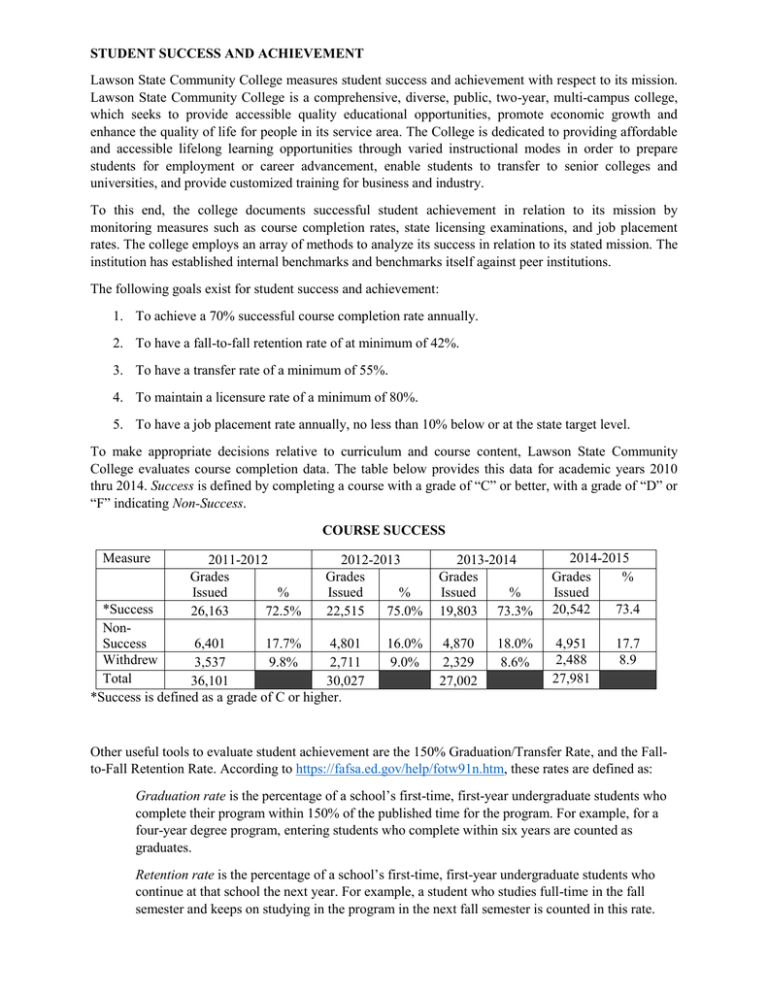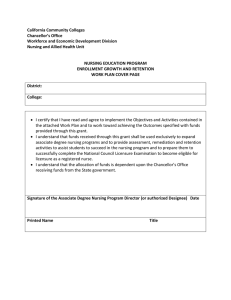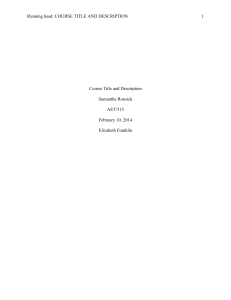STUDENT SUCCESS AND ACHIEVEMENT
advertisement

STUDENT SUCCESS AND ACHIEVEMENT Lawson State Community College measures student success and achievement with respect to its mission. Lawson State Community College is a comprehensive, diverse, public, two-year, multi-campus college, which seeks to provide accessible quality educational opportunities, promote economic growth and enhance the quality of life for people in its service area. The College is dedicated to providing affordable and accessible lifelong learning opportunities through varied instructional modes in order to prepare students for employment or career advancement, enable students to transfer to senior colleges and universities, and provide customized training for business and industry. To this end, the college documents successful student achievement in relation to its mission by monitoring measures such as course completion rates, state licensing examinations, and job placement rates. The college employs an array of methods to analyze its success in relation to its stated mission. The institution has established internal benchmarks and benchmarks itself against peer institutions. The following goals exist for student success and achievement: 1. To achieve a 70% successful course completion rate annually. 2. To have a fall-to-fall retention rate of at minimum of 42%. 3. To have a transfer rate of a minimum of 55%. 4. To maintain a licensure rate of a minimum of 80%. 5. To have a job placement rate annually, no less than 10% below or at the state target level. To make appropriate decisions relative to curriculum and course content, Lawson State Community College evaluates course completion data. The table below provides this data for academic years 2010 thru 2014. Success is defined by completing a course with a grade of “C” or better, with a grade of “D” or “F” indicating Non-Success. COURSE SUCCESS Measure 2011-2012 Grades Issued % 26,163 72.5% 2012-2013 Grades Issued % 22,515 75.0% *Success NonSuccess 6,401 17.7% 4,801 Withdrew 3,537 9.8% 2,711 Total 36,101 30,027 *Success is defined as a grade of C or higher. 16.0% 9.0% 2013-2014 Grades Issued % 19,803 73.3% 2014-2015 Grades % Issued 20,542 73.4 4,870 2,329 27,002 4,951 2,488 27,981 18.0% 8.6% 17.7 8.9 Other useful tools to evaluate student achievement are the 150% Graduation/Transfer Rate, and the Fallto-Fall Retention Rate. According to https://fafsa.ed.gov/help/fotw91n.htm, these rates are defined as: Graduation rate is the percentage of a school’s first-time, first-year undergraduate students who complete their program within 150% of the published time for the program. For example, for a four-year degree program, entering students who complete within six years are counted as graduates. Retention rate is the percentage of a school’s first-time, first-year undergraduate students who continue at that school the next year. For example, a student who studies full-time in the fall semester and keeps on studying in the program in the next fall semester is counted in this rate. Transfer rate is the percentage of a school’s first-time, first-year undergraduate students who transfer to another college within 150% of the published time for the program. For example, a student who is in a four-year degree program is counted as a transfer if the student goes to another college within six years. 2011-2012 2012-2013 2013-2014 2014-2015 Percentage Returned or Earned Award Headcount Year Total Headcount FALL-TO-FALL RETENTION RATES 4,105 3,258 2,933 2,927 1,802 1,590 1,420 1,512 43.9% 48.8% 48.4% 51.7% IPEDS GRADUATION AND TRANSFER RATES Fall Cohort Graduation Rate 150% Transfer Out Rate 2012 13% 32% 2011 10% 31% 2010 18% 41% 2009 17% 33% 2008 17% 35% The college monitors the rate of credentials awarded. The college awards the following: Associate of Arts, Associate of Science, Associate of Applied Science, Associate of Occupational Technology, and certificates of varying program lengths. CREDENTIALS AWARDED Year Associate Degrees Certificates Total Change from previous year 2014-2015 239 345 584 +25.3 2013-2014 226 210 436 -30.5% 2012-2013 281 346 627 -3.8% 2011-2012 280 372 652 1.9% STATE LICENSING The College has three programs which require state licensing prior to becoming employed in field: Associate Degree Nursing, Practical Nursing, and Cosmetology. Both the Associate and Practical Nursing Programs are approved by the Alabama Board of Nursing. Candidates for licensure must pass the National Council Licensure Examination for Registered Nurses or the National Council Licensure Examination for Practical Nurses, depending on their completed program of study. Cosmetology completers must pass both a practical and written examination in order to receive licensure. The Alabama State Board of Nursing currently has a benchmark of 80% passage for the NCLEX. Lawson State sets an internal benchmark of 80% as well. Both the Associate Degree Nursing Program and the Practical Nursing Program have exceeded this benchmark for the past four testing cycles. Also, with the exception of the 2010-11 Associate Nursing Program, Lawson State has surpassed the National Mean each year. 46 21 18 19 44 21 17 19 95.7% 100% 94.4% 100% 80% 80% 80% 80% NATIONAL MEAN STATE BENCHMARK PASSED TESTED YEAR 2011-12 2012-13 2013-14 2014-15 PASSAGE RATE LAWSON STATE NCLEX LICENSING EXAM ADN 90.2 84.3 81.7 83.3 2011-12 2012-13 2013-14 2014-15 15 12 16 11 15 12 15 11 100% 100% 93.8% 100% 80% 80% 80% 80% NATIONAL MEAN STATE BENCHMARK PASSAGE RATE LAWSON STATE PASSED TESTED YEAR NCLEX LICENSING EXAM PN 84 84.7 82.8 82.1 2009 2010 2011 2012 2013 2014 2015 *Calendar year 2 7 4 8 11 3 2 100% 100% 100% 100% 100% 100% 100% 7 8 11 19 10 9 3 PASSAGE RATE NUMBER TESTED WRITTEN PASSAGE RATE NUMBER TESTED PRACTICAL *EXAMINATIO N PERIOD COSMETOLOGY BOARD RESULTS 42.9% 100% 54.5% 73.7% 70.0% 66.67% 66.67% JOB PLACEMENT RATES Another indicator of student success and achievement is the job placement rate. Using the College Performance Report on Career and Technical Education (Perkins), specifically Core Indicator 4P1, placement rates are scrutinized and reviewed yearly. Core Indicator 4P1 requires measuring the percent of concentrators employed, in military, or apprenticeship programs in the 2nd quarter following the term in which they left postsecondary. Statewide goals are determined each year by the Alabama Department of Postsecondary Education. PLACEMENT Defined as percentages of career tech concentrators employed, in military or apprenticeship programs in the 2nd quarter following the term they left postsecondary institution. Year 2014-2015 2013-2014 2012-2013 2011-2012 2010-2011 Job Placement Rate 74.03% 72.54% 71.94% 71.10% 66.31% State Target Level 80.00% 80.00% 80.00% 79.00% 84.44% File: Student Success and Achievement and SACSCOC 4.1



